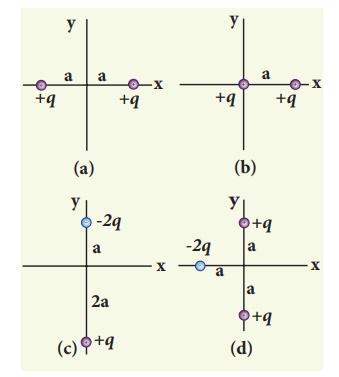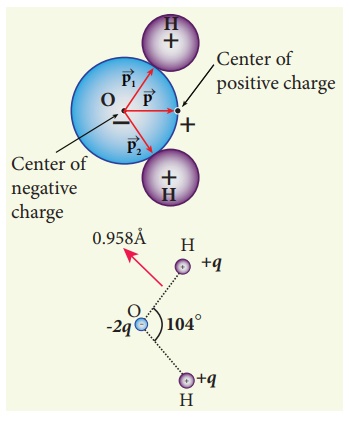Chapter: 12th Physics : Electrostatics
Electric Dipole : Solved Example Problems
EXAMPLE 1.10
Calculate the electric dipole moment for the following charge configurations.

Solution
Case (a) The position vector for the +q on the positive x-axis is ai and position vector for the +q charge the negative x axis is -a i ^ . So the dipole moment is,

Case (b) In this case one charge is placed at the origin, so its position vector is zero. Hence only the second charge +q with position vector ai contributes to the dipole moment, which is ![]() = qa
= qa![]() .
.
From both cases (a) and (b), we can infer that in general the electric dipole moment depends on the choice of the origin and charge configuration. But for one special case, the electric dipole moment is independent of the origin. If the total charge is zero, then the electric dipole moment will be the same irrespective of the choice of the origin. It is because of this reason that the electric dipole moment of an electric dipole (total charge is zero) is always directed from –q to +q, independent of the choice of the origin.
Case (c)  . Note that in this case p is directed from -2q to +q.
. Note that in this case p is directed from -2q to +q.
Case (d) 
The water molecule (H2O) has this charge configuration. The water molecule has three atoms (two H atom and one O atom). The centers of positive (H) and negative (O) charges of a water molecule lie at different points, hence it possess permanent dipole moment. The O-H bond length is 0.958 × 10-10 m due to which the electric dipole moment of water molecule has the magnitude p = 6.1 x 10-30 Cm. The electric dipole moment ![]() is directed from center of negative charge to the center of positive charge, as shown in the figure.
is directed from center of negative charge to the center of positive charge, as shown in the figure.

EXAMPLE 1.11
A sample of HCl gas is placed in a uniform electric field of magnitude 3 × 104 N C-1. The dipole moment of each HCl molecule is 3.4 × 10-30 Cm. Calculate the maximum torque experienced by each HCl molecule.
Solution
The maximum torque experienced by the dipole is when it is aligned perpendicular to the applied field.
τmax = pE sin 90 = 3 .4×10−30 ×3 ×104 N m
τmax = 10.2 ×10−26 N m
Related Topics